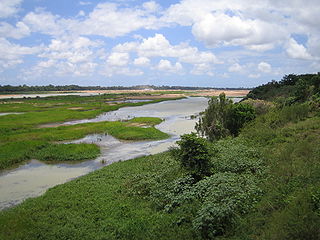
The Burdekin River is a river in North and Far North Queensland, Australia. The river rises on the northern slopes of Boulder Mountain at Valley of Lagoons, part of the western slope of the Seaview Range, and flows into the Coral Sea at Upstart Bay over 200 kilometres (124 mi) to the southeast of the source, with a catchment area of approximately 130,000 square kilometres (50,000 sq mi). The Burdekin River is Australia's largest river by (peak) discharge volume.

The Gordon River is a major perennial river located in the central highlands, south-west, and western regions of Tasmania, Australia.

John Job Crew Bradfield was an Australian engineer best known as the chief proponent of the Sydney Harbour Bridge, of which he oversaw both the design and construction. He worked for the New South Wales Department of Public Works from 1891 to 1933. He was the first recipient of an engineering doctorate from the University of Sydney, in 1924. Other notable projects with which he was associated include the Cataract Dam, the Burrinjuck Dam, and Brisbane's Story Bridge. The Harbour Bridge formed only one component of the City Circle, Bradfield's grand scheme for the railways of central Sydney, a modified version of which was completed after his death. He was also the designer of an unbuilt irrigation project known as the Bradfield Scheme, which proposed that remote areas of western Queensland and north-eastern South Australia could be made fertile by the diversion of rivers from North Queensland.
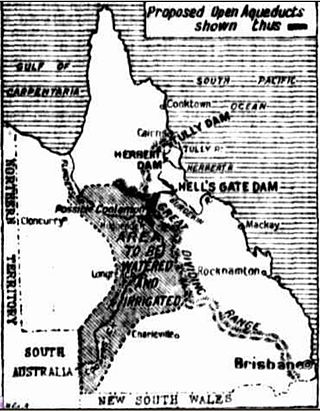
The Bradfield Scheme, a proposed Australian water diversion scheme, is an inland irrigation project that was designed to irrigate and drought-proof much of the western Queensland interior, as well as large areas of South Australia. It was devised by Dr John Bradfield (1867–1943), a Queensland born civil engineer, who also designed the Sydney Harbour Bridge and Brisbane's Story Bridge.

The Wivenhoe Dam is a rock and earth-fill embankment dam with a concrete spillway across the Brisbane River in South East Queensland, Australia. The dam takes it names from the local Wivenhoe Pocket rural community. The dam wall is located about 80 kilometres (50 mi) by road from the centre of Brisbane. The primary purpose of the dam is the supply of potable water for the Brisbane and Ipswich regions. The dam also provides for flood mitigation control, hydroelectricity, and recreation. The impounded reservoir is called Lake Wivenhoe and the dam, the lake and a narrow strip of surrounding land forms a locality also called Lake Wivenhoe.

Theodore is a rural town and locality in the Shire of Banana, Queensland, Australia. In the 2016 census the locality of Theodore had a population of 438 people.

The Lockyer Creek is a creek in South East Queensland, Australia. A tributary of the Brisbane River, the creek is a major drainage system in the Lockyer Valley. Rising on the eastern slopes of the Great Dividing Range, the creek flows generally north-easterly for more than 100 kilometres (62 mi) before it reaches its confluence with the Brisbane River north-northeast of Lowood, and downstream from the Wivenhoe Dam. The creek is named after Edmund Lockyer.
The Barron Gorge Hydroelectric Power Station in Queensland, Australia is an electricity power station commissioned in 1963 with a maximum capacity of 66 megawatts (89,000 hp). It is located in the locality of Barron Gorge in the Wet Tropics World Heritage Area 20 kilometres (12 mi) north-west of Cairns. It replaced an earlier station which was the first underground power station in the country and the first hydroelectric station in Queensland. The power station was refurbished in 2006.
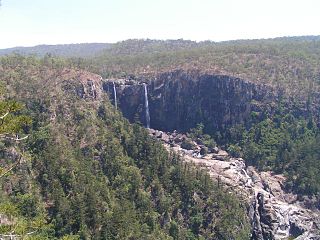
The Herbert River is a river in Far North Queensland, Australia. The southernmost of Queensland's wet tropics river systems, it was named in 1864 by George Elphinstone Dalrymple explorer, after Robert George Wyndham Herbert, the first Premier of Queensland.
The Kareeya Hydro Power Station near Tully in Queensland, Australia in a hydroelectric power station that began generating power in 1957. It has a capacity of 88 megawatts (118,000 hp) which is fed into the National Electricity Market. The power station is owned by CleanCo Queensland.
The Rubicon River, an inland perennial river of the Goulburn Broken catchment, part of the Murray-Darling basin, is located in the lower South Eastern Highlands bioregion and Northern Country/North Central regions of the Australian state of Victoria. The headwaters of the Rubicon River rise on the western slopes of the Victorian Alps and descend to flow into the Goulburn River.
Koombooloomba is a rural locality in the Tablelands Region, Queensland, Australia. In the 2016 census Koombooloomba had a population of 0 people.

The Butlers Gorge Power Station is a conventional hydroelectric power station located in the Central Highlands region of Tasmania, Australia.
The Koombooloomba Dam is a concrete gravity dam with a controlled spillway across the Tully River, located west of Tully and south, southeast of Ravenshoe in Far North Queensland, Australia. Built for the purpose of hydroelectric power generation, the dam creates the reservoir, Lake Koombooloomba.

The Western Corridor Recycled Water Scheme, a recycled water project, is located in the South East region of Queensland in Australia. The scheme is managed by Seqwater and forms a key part of the SEQ Water Grid constructed by the Queensland Government in response to population growth, climate change and severe drought. The A$2.5 billion project is reported as the largest recycled water project in Australia. As of 2019, the scheme has been constructed and its performance has been validated. It remains in care and maintenance mode, and will commence operation after SEQ Water Grid dam levels reach 60%.
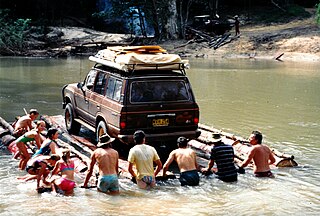
The Wenlock River is a river located on the Cape York Peninsula in Far North Queensland, Australia.

The Tully Falls, a horsetail chute waterfall on the Tully River, is located in the UNESCO World Heritage–listed Wet Tropics in the Far North region of Queensland, Australia. It formed the eastern boundary of the Dyirbal.

The Johnstone River, comprising the North Johnstone River and the South Johnstone River, is a river system in Far North and North Queensland, Australia.
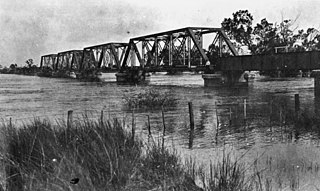
The Nogoa River is a river in Central Queensland, Australia.

The Mossman River is a river in lower Cape York Peninsula, Queensland, Australia.
















